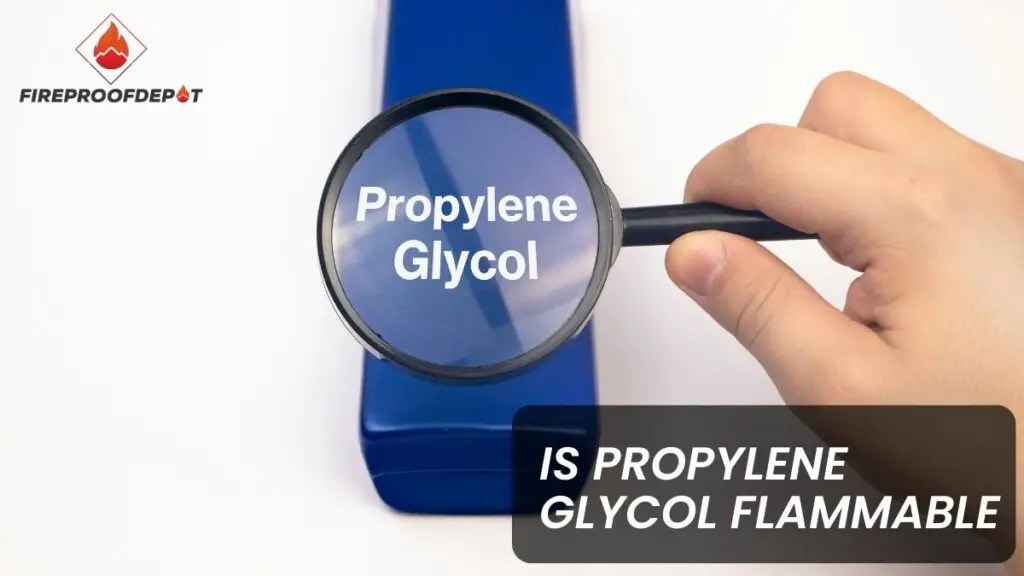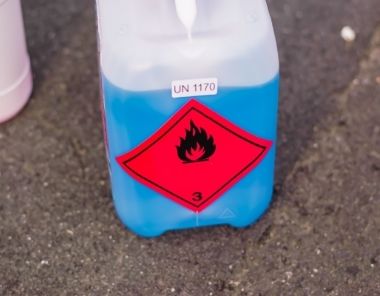No, propylene glycol is not used daily, and you won’t find yourself working with it unless you’re in the food industries, medicines, or cosmetics. And if you’re working with the chemical every day, it’s normal to wonder about its safe usage.
So, is propylene glycol flammable?
Yes, propylene glycol is an averagely flammable liquid. And as per the data from the Occupational Safety and Health Administration, it is not considered a hazardous or highly flammable substance.
However, there’s a catch. It still tends to ignite or help in combustion under certain circumstances.
If you’re here to know about these and all other flammability facts of propylene glycol, you’re in the right place. Let’s get you to utmost safety with interesting facts and safety precautions on this substance!

Understanding Flash Point and Flammability of Propylene Glycol
Although not the most common or regularly used chemical out there, propylene has multipurpose usage in the food industries, cosmetics, pharmaceuticals, and so on.
To state the basic facts, propylene glycol is a colorless, thick liquid with a very slight, pleasantly sweet flavor and no discernible odor. It is easy to mix up with a number of solvents, including water, acetone, and even chloroform. Besides, the volatility numbers for this substance are very low and are often non-irritating.
Propylene has widespread usage thanks to all these factors and its relatively less flammable property. However, it’s not non-flammable, nor is it a flame retardant. Hence, safety concerns when using it are typical. We’ll get to that later, but for now, let’s tell you a bit more about its flammability.
Flash Point
Before telling you all about the flash point of propylene glycol, let’s clear out what flash point really means. To put it straight, the lowest temperature at which a liquid may ignite when exposed to an ignition source and may keep on burning on its own even when the source is removed is known as the flash point.
For propylene glycol, the flash point is around 100 degrees C or 212 degrees F. Compared to some highly flammable liquids, such as gasoline or ethanol, this temperature is quite high. Hence, the ignition or combustion risks are low in the case of this substance.
However, when heated above the flash point, propylene glycol can emit flammable vapors that tend to ignite or catch fire in the presence of an ignition source. It can be an igniting flame or even a simple spark.
Flammability
Thanks to its moderately high flash point, propylene glycol is not regarded as a substance that easily catches fire. However, when 100 degrees C is reached, it will produce combustible fumes, and in contact with any ignition source, it can also catch fire.
Besides, even when propylene glycol comes into contact with other flammable substances, it can start igniting too.
What Properties Make Propylene Glycol Flammable?
Here’s an interesting fact about propylene glycol, it is well-known for its distinctive property of being able to act both as an emulsifier and a solvent. Moving on to its flammability, if you’re handling this substance, you must be aware of its flammable properties. So, let’s tell you all about it!
Low Flash Point
As you already know, the flashpoint is the temperature at which a substance ignites. In comparison to other flammable liquids, propylene glycol has a comparatively high flash point of around 100 degrees C. However, it does not mean that there’s no risk of catching fire or assistance in combustion by the substance.
After the flash point, if you still keep adding heat to it, propylene glycol will start releasing combustible fumes. So, although its flash point may be comparatively lower than a few highly flammable substances, it still possesses a potential fire hazard.
Relatively Low Heat Capacity
Another property of propylene glycol that may influence its flammability is its heat capacity. Let’s define heat capacity before that.
The quantity of heat energy absorbed by a substance before its temperature rises is known as the heat capacity of the particular substance. For a diluted propylene glycol mixture at 40%, the specific heat stands at 0.895.
Due to its poor heat capacity, propylene glycol heats up sooner than you think and reaches its flash point in a jiffy when exposed to a heat source. Because of this risky property of propylene glycol, you should ensure storing it in cold places away from heat sources.
High Vapor Density
Moving on, we have the high vapor density of propylene glycol that contributes to its flammability.
The weight of vapor in relation to an equivalent amount of hydrogen at the same temperature and pressure is referred to as its vapor density. In the case of propylene glycol, it has a larger vapor density than air.
This property of propylene glycol vapors allows them to accumulate close to the ground and increases fire or explosion risk.
Highly Reactive with Certain Substances
Although propylene seems somewhat harmless, it shows high reactivity with certain compounds, which alleviates the risk of ignition. A substance’s capacity to react with another one and eventually produce energy is referred to as its reactivity.
Although propylene isn’t highly reactive like some similar chemicals, it sure shows high reactivity when combined with certain compounds. Such as it reacts with strong oxidizers to generate flammable gasses.
And as you can understand, the best way to deal with this is to store it way apart from incompatible components!
Good Conductor of Electricity
Being an excellent conductor of electricity, propylene glycol can easily start a fire as it comes in contact with an electrical source or even something as simple as a spark! Not only direct propylene glycol but abrupt spills of the chemical or improper grounding of electrical equipment have the potential to cause the mishap.
Safety Measures to Reduce Fire or Explosion Risks of Propylene Glycol
While propylene glycol is often labeled as a harmless and safe chemical, if you somehow handle it in the wrong way or cause some spills in the wrong place, it may result in a fire or even an explosion. Of course, no one wants that. So, here are safety measures to avoid any fire risks from it.

Careful Storage Is the Priority!
Hear this out attentively; you must keep propylene glycol in a cold, dry area after you’re done using it! No doubt, this has to be one of the most crucial steps toward ensuring safety when storing this liquid.
By doing this, you can also avoid any sudden chemical overheating. You know what can happen with overheating; the chemical will reach its flash point, and sooner than you realize it will release flammable vapors.
Besides, as you can presumably understand, you must also keep it away from any kind of heat source, whether it’s an open fire, an electrical source, or simply a heated surface.
Ensure Proper Ventilation
When handling propylene glycol, ensure you’ve arranged proper ventilation for it. This helps in avoiding the buildup of fumes, which might raise the possibility of a fire or even an explosion.
Even if propylene glycol releases any flammable fumes, adequate ventilation will quickly disperse it, lowering possibilities for ignition or combustion of neighboring substances. Besides, don’t forget to wear a respirator or employ a ventilation system if you’re working in a poorly ventilated zone.
Read and Follow the Handling Manual
Whether you’re handling propyl glycol or any other flammable substance, there is no other way of preventing accidents than to safely handle it in the first place.
This means that you should use properly sized container material for storage and transportation, avoid any spills, and properly label the container with what content is inside and its potential hazards.
Besides, be very careful not to mix propylene glycol with other chemicals, especially those that are incompatible or easily react with it to create dangerous flammable vapors.
Don’t Forget Protective Clothing and Accessories!
If you’re handling propylene glycol by yourself, do not neglect or compromise with wearing proper safety gear and apparel. The list includes safety accessories such as protective goggles, gloves, and protective clothing like aprons and coats.
In case of an unfortunate fire or explosion, these clothing and accessories can minimize the risk of damage by shielding your skin and eyes from chemical or flame exposure. So, no ignorance there!
Remember to Include Fire Safety
Accidents, especially fire accidents, are so common these days that even with the finest safety precautions in place, you cannot seem to avoid them. Hence, it is significant that you have emergency fire solutions in the event of a fire or explosion.
Yes, even after wearing protective clothing, safe handling of propylene glycol, and good ventilation, you must ensure there’s a fire extinguisher close at hand. Moreover, you must be familiar with safe evacuation procedures and remember to keep a first aid kit nearby in case of minor accidents.
Frequently Asked Questions
1. Is propylene glycol explosive?
Under normal atmospheric conditions, propylene glycol doesn’t pose any risk of explosion. However, if it is heated to an extreme temperature above its flash point or comes in proximity to a strong oxidizer, it may ignite or even explode.
2. Can you safely heat propylene glycol?
Its flash point is over 100 degrees C; it is safe to heat propylene glycol. However, heating propylene glycol changes its composition, producing propylene oxide, which is carcinogenic, so this isn’t really safe!
3. What happens if you burn propylene glycol?
As you know, there are hydrocarbons in glycerin. So when you burn propylene glycol, it partially oxidizes. And as you keep burning it, it will result in water and carbon dioxide.
Wrapping Up!
Yes, although it’s not enlisted as a highly flammable liquid, propylene glycol is somewhat flammable. And if the conditions are right, it might even result in an explosion in no time.
No need to worry because all you need to do is follow the safety measures when handling this substance. And make sure you keep it away from sunlight or any other heat source. Better to be safe than to be sorry! And that’s all for today, folks. Learn more every day, and stay safe!
